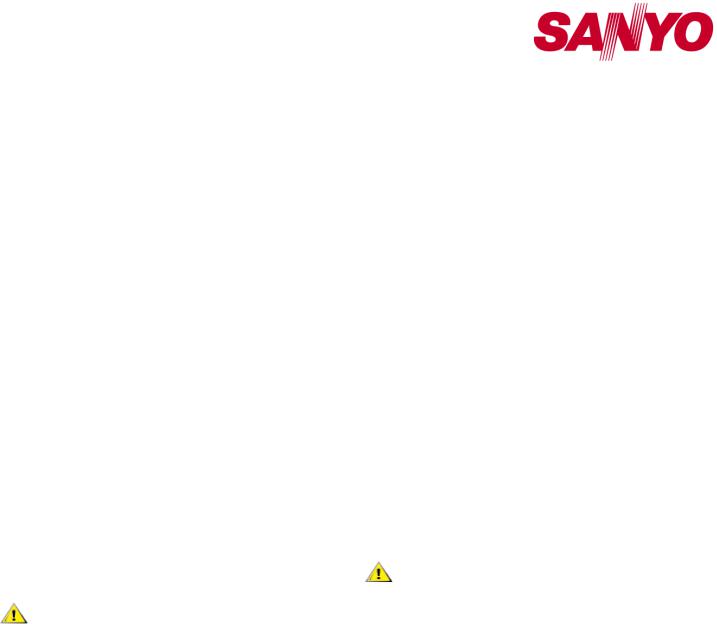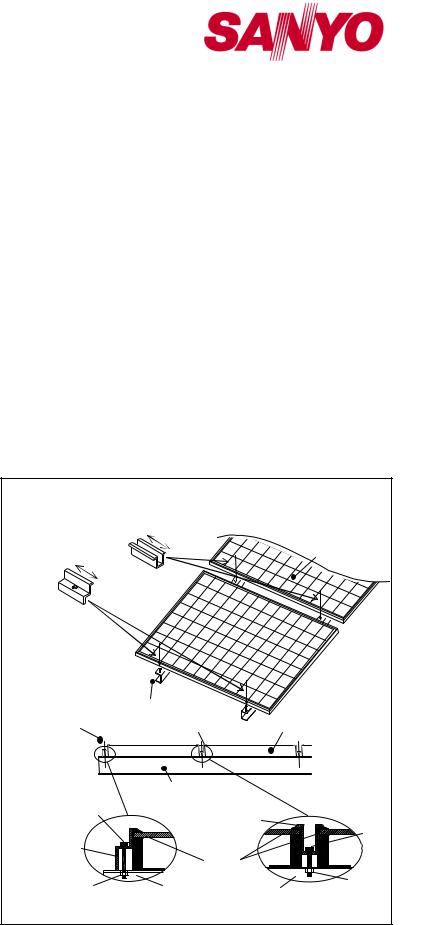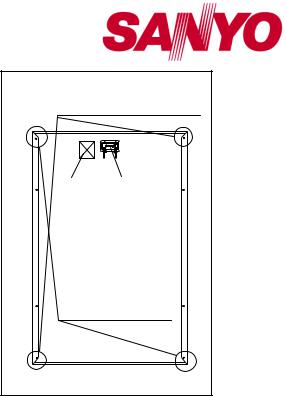Sanyo HIP-180BA19 Installation Manual

General Installation Manual
© Jun 2011, Sanyo Electric Co., Ltd. All Rights Reserved. 6/13/11
General Installation Manual for SANYO HIT® Photovoltaic Modules. Please read this manual carefully before installing or using HIT Power modules. This manual applies to the following models:
HIT Power 205 (HIP-205BA19,BA20)
HIT Power 200 (HIP-200BA19,BA20)
HIT Power 195 (HIP-195BA19,BA20)
HIT Power 190 (HIP-190BA19,BA20)
HIT Power 186 (HIP-186BA19,BA20)
HIT Power 180 (HIP-180BA19,BA20)
INTRODUCTION
Thank you for choosing SANYO HIT Power photovoltaic (PV) modules. With proper operation and maintenance, your solar PV modules will provide you with clean, renewable solar electricity for many years. This manual contains important installation, maintenance and safety information. The word “module” as used in this manual refers to one or more PV modules. Retain this manual for future reference.
Disclaimer of Liability
SANYO does not assume responsibility and expressly disclaims liability for loss, damage, or expense arising out of, or in any way connected with installation, operation, use, or maintenance by using this manual.
SANYO assumes no responsibility for any infringement of patents or other rights of third parties, which may result from use of modules.
No license is granted by implication or under any patent or patent rights. The information in this manual is believed to be reliable, but does not constitute an expressed and/or implied warranty.
SANYO reserves the right to make changes to the product, specifications, data sheets and this manual without prior notice.
General Information
The installation of solar modules requires a great degree of skill and should only be performed by qualified licensed professionals, including, without limitation, licensed contractors and electricians.
WARNING
•All instructions should be read and understood before attempting to install, wire, operate, or maintain a PV module.
•Work only in dry conditions, with dry modules and insulated tools.
•Do not stand or step on modules.
•Do not puncture, cut, scratch or damage the back sheet of a module. Back sheet damage will void a module’s Limited Warranty and may cause fire.
Never use modules with a damaged back sheet.
•Do not allow children and unauthorized persons near the installation or storage site of modules.
•Completely ground all modules.
•Do not disassemble a module, attempt any repair, open the junction box cover, nor remove any parts installed by Sanyo. There are no user serviceable parts within the module or junction box.
•Wear suitable clothing, guards, eye protection and gloves and remove metallic jewelry to prevent yourself from direct contact with 30 Volts DC or greater.
•Wear non-slip gloves and carry modules by its frame with two or more people.
•Do not carry a module by its wires or junction box.
•Do not drop anything on the surfaces of a module.
•Ensure all system components are compatible, and they do not subject the module to mechanical or electrical hazards.
•Sparks may occur; do not install the module where flammable gases or vapors are present.
•Never rest or leave a module unsupported or unsecured.
•Do not drop a module.
•Do not use or install broken modules.
•Do not artificially concentrate sunlight on a module.
•Do not touch a PV module unnecessarily. The glass surface and frames get hot. There is a risk of burn.
CAUTIONS
•Use a module for its intended purpose only.
•Do not treat the back sheet, frame, or front surface with paint or adhesives, to avoid reducing its’ functionality, damage, and causing inoperable conditions or other unknown trouble.
•Contact with electrically active parts of the module such GENERAL SAFETY
as terminals can result in sparks, injury, fire, burns, and Follow all applicable codes, permission, installation and lethal shock whether the module is connected or inspection requirements.
disconnected.
•The installer assumes the risk of all injury that might occur during installation.
•PV modules generate direct current (DC) electrical energy when exposed to sunlight or other light sources.
•Even a single module produces enough voltage and current to cause shocks and burns if safety precautions are not followed.
•The shock hazard increases as modules are connected in parallel, producing higher current, and as modules are connected in series, producing higher voltages.
•To avoid the hazards of electric sparks, shock, fire, burns, injury, and damage:
•Cover the entire front surface of the PV module with a dense, opaque material such as a cardboard box or cloth, during installation and handling.
•Before installing modules, contact the appropriate authorities to determine any codes, permissions, installation and inspection requirements that apply.
•Electrically ground modules for all systems of any voltage. If not otherwise specified, it is recommended that requirements of the latest National Electrical Code (USA) or Canadian Electric Code (Canada) or other applicable local, national, or international electrical standards be followed. Refer to “System Grounding” section for more information.
•Be sure the building or structure (roof, façade, etc.) where the modules are being installed has enough strength to support the load of the modules.
•For modules mounted on roofs, special structures may be required to provide proper installation support.
•Both roof construction and module installation design have an effect on the fire resistance of a building. Improper installation
1

General Installation Manual
© Jun 2011, Sanyo Electric Co., Ltd. All Rights Reserved. 6/13/11
may contribute to fire hazards. Additional devices such as ground fault, fuses, and disconnects may be required.
•Do not use modules of different power specifications, in the same string.
•Follow all safety precautions of other system components and BOS parts.
UL Listing Information
To satisfy UL requirements, when installing a module, be sure to:
•Use only stranded or solid copper single–conductor sunlightresistant cable rated for outdoor use (e.g. type UF or USE) , for all wiring that is exposed to weather.
•Observe the requirements described in sections labeled INSTALLTION and SPECIFICATIONS.
INSTALLATION
Please read this guide completely before installing or using your Sanyo PV modules. This section contains important electrical and mechanical specifications.
•Modules should be firmly fixed in place in a manner suitable to withstand all expected loads, including wind and snow loads.
•Metals used in locations exposed to moisture shall not be employed alone or in combinations that could result in deterioration or corrosion.
•Install modules where they are not shaded by obstacles like buildings and trees. Pay special attention to avoid partially shading modules by objects during the daytime.
•If needed, contact an Authorized Representative with questions regarding mounting profiles for Sanyo modules.
¾Thickness : 0.12”(3 mm)
¾Torque range: 16N.m to 20N.
¾Material: Aluminum Alloy
Sanyo does not provide a warranty for clamps. The module warranty Sanyo provides shall be voided if clamps selected by the customer are of an improper material or size.
Operating Conditions
SANYO requires that modules be operated within the following conditions:
•Modules are intended for use in terrestrial applications only— no outer space use.
•Modules must not be installed or operated in areas where, salt, hail, snow, sand, dust, air pollution, chemically active vapors, acid rain, soot, etc., are excessive.
•The ambient temperature must be within –20°C (-4°F) to 46°C (115°F). The temperature limits are defined as the monthly average high and low of the installation site.
•The wind pressure load of the installation site should be less than 2,880N/m2 (60PSF).
SPECIFICATIONS
•Rated electrical characteristics are within –5% to +10% of the
values measured at Standard Test Conditions (STC). STC conditions are; Irradiance of 1000W/m2, 25oC cell temp., solar spectral irradiance per IEC 60904-3.
• Under |
normal conditions, a |
photovoltaic module may |
|
experience |
conditions that produce more current and/or |
||
voltage |
than |
reported at |
Standard Test Conditions. |
Notes on Installation
•Clearance between the roof surface and module frame is required to allow cooling air to circulate around the back of the module. This also allows any condensation or moisture to dissipate. Install modules with a minimum of 1 inch clearance between the roof surface and the modules so that air can circulate.SANYO recommends the installation method and mounting profile shown in Figure 1.
•A module should be attached on a mount or support structure rail by corrosive-resistant metal clamps.
•The clamps should be made of aluminum alloy or other material that will reasonably protect against the a risk of electrolytic corrosion.
•Recommendation of bolt torque range: 16N.m to 20N.m
•The module was tested using Unirac clamps with the specifications below; if a different clamp is used it must have a design load capacity equivalent to or greater than the load specified in this Manual.
¾Provider: UniRac, Inc.
¾Part number: SolarMount®
¾Clamps type: Top Mounting Clamps
¾Clamp size:Mid clamp and End clamp, F size,
¾Unirac Part No.320029, 320102
¾Width: 1.5” (38 mm)
Installation (reference) |
|
|
|
|
38mm |
|
Solar Module |
38mm |
|
||
|
|
||
|
Metal clamp B |
|
|
|
(2 places) |
|
|
Metal clamp A |
|
|
|
(2 places) |
|
|
|
|
Mounting |
|
|
Metal clamp A |
Structure Rail |
|
|
Metal clamp B |
|
Solar Module |
|
|
|
||
|
Mounting Structure Rail |
|
|
M8 Bolt |
|
|
|
|
Metal clamp B |
|
M8 Bolt |
Metal clamp A |
|
|
|
|
Module |
|
|
M8 Nut |
Mounting Structure |
M8 Nut |
|
|
|||
|
End of Module |
Between Modules |
|
Figure 1. Installation
2

General Installation Manual
© Jun 2011, Sanyo Electric Co., Ltd. All Rights Reserved. 6/13/11
Accordingly, the values of Isc and Voc marked on UL listed modules should be multiplied by a factor of 1.25 when determining voltage ratings, conductor capacities, fuse sizes, and size of controls connected to the module output. Refer to
Section 690 of the National Electrical Code for an additional multiplying factor of 1.25 which may be applicable.
•The current output for modules shown in the SPECIFICATIONS section is measured at Standard Test Conditions. These conditions may not be frequently observed in actual practice.
Mechanical Loading
•Modules should be mounted at four (4) symmetrical quarter points by the means shown in Figures 1 and 2.
•This method offers a maximum load of 2,880N/m2 (60PSF) in a static state on the module surface. Note: This 60PSF mechanical loading value was tested with mouting device specified in section “Notes on Installation”.
WIRING
•All wiring should be done in accordance with applicable electrical codes.
•Wiring methods should be in accordance with the NEC in USA or CEC in Canada.
•A qualified, licensed professional should do all wiring.
•Wiring should be protected to help ensure personal safety and to prevent its damage.
•All modules connected in series should be of the same model number and/or type.
•Do not connect modules in parallel without using a connection box that connects appropriate FUSE for each series string or each module.
•Do not disconnect terminals while PV modules generate electricity and connect electrical load to avoid the hazard of electrical shock.
•To avoid the hazard of electric shock and sparks, please connect each cable after confirming the polarity of them is correct.
•Cable conduits should be used in locations where the wiring is inaccessible to children or small animals.
Module Wiring
•The number of modules that can be wired in series is recommended at seven (7) or fewer. If connecting eight (8) modules in series, check local temperature conditions and follow the National Electric Code (690.7) to ensure compliance with maximum voltage limitations.
•Modules are not designed for “off-grid” or battery charging systems, because of their operating voltage. Therefore, it is not recommended to use them to charge batteries.
•These modules contain four (4) factory installed bypass diodes. If these modules are incorrectly connected to each other, the bypass diodes, cable, or junction box may be damaged.Array Wiring
•The term “array” is used to describe the assembly of several modules on a support structure with associated wiring.
•Use copper wire that is sunlight resistant and is insulated to withstand the maximum possible system open circuit voltage.
•Check local codes for requirements.
System Grounding
Ground Locations
(Smaller holes for self-tapping screw method)
Label Junction Box
Backside
The ground holes are on the backside of the module frame.
Ground Locations
(Larger holes for bolt and nut method)
Figure 3.1
Module Ground Locations
•Ground the frame of the module or array to avoid the hazards of electric shock or fire.
•The array frame shall be grounded in accordance with NEC Article 250 (USA) or CEC in Canada.
•Bonding shall be by a positive means, such as clamping, riveting, bolted or screwed connectors, welding, soldering or brazing. If the bonding means depends upon screw threads, two or more screws, or two full threads of a single screw must engage the metal.
•All the washers illustrated in Figures 3.2 and 3.3 are required as part of the grounding connection.
•Great care should be exercised to ensure that corrosion caused by the grounding means is avoided.
•Corrosion can increase the resistance of the grounding connection on the module, or can even cause the grounding connection to fail entirely.
•Corrosion can be caused by the effects of weather, humidity, dirt and so on. Corrosion can also be caused when two dissimilar metals contact each other (galvanic action).
•The module frame material is aluminum/magnesium alloy.
•All fasteners (nuts, bolts, washers, screws, etc.) must be stainless steel unless otherwise specified.
•Length of self-tapping screws or bolts should not be more than 0.78in (20mm) in order to avoid contacting the back sheet of the module.
• Acceptable grounding wire is following. Ilsco Corp. GBL-4DBT 10-14AWG-Solid, 4-6, 8, 10-14AWG- Strand
Burndy L L C CL501TN 14AWG-Solid, 14-4AWG-Strand Tyco Electronics Corp. 1954381-1/1954381-2 10-12AWG Solid
•Each ledge on the module frame has two smaller holes for self-tapping screws of 0.165” diameter (4.2mm) and two larger holes for bolts of 0.205” diameter (5.2mm).
3
